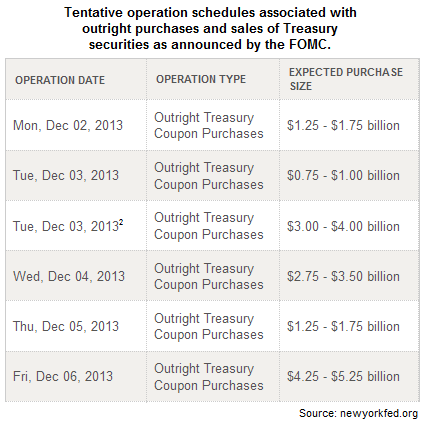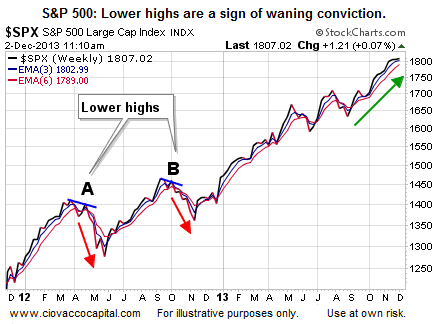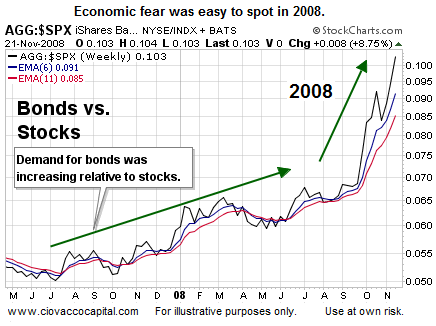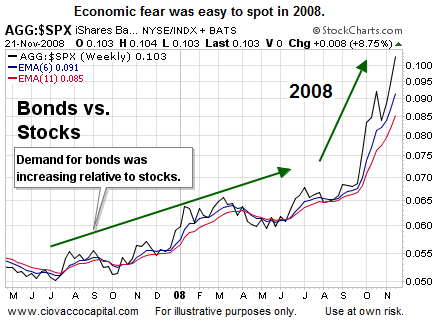Lately we have been hearing rumblings in the media that the market is getting “too frothy” and looking like a “bubble” and the media is wondering if we are nearing 2008 proportions. Usually as long as we hear talk like that the market is safe because when we are really nearing a top all the media will be talking about is “How high can this possibly go?” projections will be double or triple or Ten times whatever it is now. When market euphoria is high and risk is even higher doom and gloom doesn’t sell newspapers so all you will hear is good news, no talk of risk or crashes. So just the fact that there is talk of a crash is one indicator that we probably won’t have one. But in today’s article, Chris Ciovacco presents several other indicators about why the market isn’t ready to crash yet. In it he covers:
1) The FED’s Bond Buying Program
2) No “Rollover” or Lower Highs
3) Investors are Not “Defensive” i.e. Not Buying Bonds
Plus he also gives us an interesting in depth video presentation.
So it is Chris’ conclusion that the market will continue to chug along for a while yet. ~Tim McMahon, editor.
2008-Like Plunge In Stocks Not Likely
Labor Market Keeps Presses Rolling
The table below puts some context around the impact of the Fed’s bond buying program. It tells us several billion dollars of freshly printed money will be pumped into the global financial system this week. The Fed’s actions greatly reduce the odds of an imminent plunge in stock prices.

Dual Mandate Speaks To Employment
The Fed has said for some time it wants to see substantial improvement in the labor market before ending this round of quantitative easing, meaning an aggressive tapering schedule is not likely to be announced in the coming weeks. From Bloomberg:
“The weakness in jobs is continuing fodder for the Fed to fulfill its most recent and steadfast comments about the support of the economy,” Holland, who oversees more than $4 billion in New York, said in a Nov. 26 phone interview. “Until the labor market gets better, the two parts of dual mandate have to be served,” he said. “I’m still pretty set in my position and prepared to see the market go higher.”
Why A 2008-Like Plunge In Stocks Is Not Likely
This week’s stock market outlook video compares 2013 to vulnerable periods in 2000 and 2008. As shown in the video, bullish economic conviction relative to bearish economic conviction is much stronger today than it was in 2000 or 2008.
Manufacturing Picks Up
If the Fed hopes to taper their bond purchases without disrupting the bull market in stocks, the economy must show signs of improvement. Monday investors were greeted with some encouraging news. From Bloomberg:
Manufacturing unexpectedly accelerated in November at the fastest pace in more than two years, pointing to a pickup in business spending that will help propel the U.S. economy in early 2014. The Institute for Supply Management’s index increased to 57.3, the highest since April 2011, from 56.4 a month earlier, the Tempe, Arizona-based group’s report showed today. Readings above 50 indicate growth. The median forecast in a Bloomberg survey of economists was 55.1. Orders, production and employment strengthened.
Bears Have Work To Do
Rapid declines in stock prices occur when bearish economic conviction greatly exceeds bullish economic conviction. When doubt starts to creep into the equation, it shows up on a chart in the form of a lower high. Lower highs often foreshadow corrective activity in equities (see A and B in the chart below). In recent weeks, stocks have been making a series of higher highs, which tells us investors remain confident about future economic and market outcomes.

Technology vs. Brick & Mortar
Traditional Black Friday sales were down from last year, but retailers are still filling orders on Cyber Monday. From Reuters:

ComScore Inc, an analytics firm, said U.S. online sales rose 17.3 percent on Thanksgiving and Black Friday, outpacing sales growth at brick-and-mortar stores. ComScore has forecast a 16 percent jump in online sales for the season, helped by greater use of mobile devices. The most visited e-commerce sites in order were those of Amazon.com Inc, eBay Inc, Walmart, Best Buy Co Inc and Target Corp, comScore said. Retailers are also being aggressive online as they look to benefit from Cyber Monday, which falls on December 2 this year. Cyber Monday is the biggest sales day of the year for e-commerce.
Tablets and smart phones make it even easier to shop online. Investors see the ever-growing role technology plays in our lives, which can be seen in the NASDAQ 100 ETF’s (QQQ) recent leadership. All things being equal, strength in technology stocks aligns with a “risk-on” market profile.

Defensive Bonds Not Waving 2008-Like Flags
When investors are nervous about the economy, earnings, and Fed policy, they prefer to be in defensive-oriented bonds rather than growth-oriented stocks. In a November 27 article we compared the demand for Treasuries (TLT) to demand for stocks. A fair counter argument is “the demand for Treasuries has been skewed by the Fed”. We can address that issue by looking at the entire bond market, rather than Treasuries in isolation. The chart below shows the demand for bonds (AGG) relative to stocks (SPY). When the ratio rises, bonds are attracting more interest than stocks. Notice how the ratio bottomed in early July 2007, or three months before stocks peaked.

The same stock/bond ratio is shown below as of December 2, 2013. The sharp contrast between 2008 and 2013 tells us a 2008-like plunge in equities does not appear to be a high probability outcome.

Investment Implications – Staying Long Until Something Changes
Our market model began redeploying cash as stocks firmed on October 9 and 10. Since the October 9 intraday low, the S&P 500 has gained 163 points. Our game plan remains unchanged; as long as the market’s pricing mechanism continues to send bullish signals, we will continue to hold a broad stake in U.S. stocks (SPY), financials (XLF), energy (XLE), small caps (IWM), and global stocks (VT). We will remain highly flexible, looking for observable evidence of a shift toward risk aversion.
This article is copyrighted by Ciovacco Capital Management, LLC. All Rights Reserved and was reprinted by permission. The original article appeared here.
You may also like:
